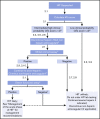American Society of Hematology 2018 guidelines for management of venous thromboembolism: heparin-induced thrombocytopenia
- PMID: 30482768
- PMCID: PMC6258919
- DOI: 10.1182/bloodadvances.2018024489
American Society of Hematology 2018 guidelines for management of venous thromboembolism: heparin-induced thrombocytopenia
Abstract
Background: Heparin-induced thrombocytopenia (HIT) is an adverse drug reaction mediated by platelet-activating antibodies that target complexes of platelet factor 4 and heparin. Patients are at markedly increased risk of thromboembolism.
Objective: These evidence-based guidelines of the American Society of Hematology (ASH) are intended to support patients, clinicians, and other health care professionals in their decisions about diagnosis and management of HIT.
Methods: ASH formed a multidisciplinary guideline panel balanced to minimize potential bias from conflicts of interest. The McMaster University GRADE Centre supported the guideline development process, including updating or performing systematic evidence reviews. The panel prioritized clinical questions and outcomes according to their importance for clinicians and patients. The Grading of Recommendations Assessment, Development and Evaluation (GRADE) approach was used to assess evidence and make recommendations, which were subject to public comment.
Results: The panel agreed on 33 recommendations. The recommendations address screening of asymptomatic patients for HIT, diagnosis and initial management of patients with suspected HIT, treatment of acute HIT, and special situations in patients with acute HIT or a history of HIT, including cardiovascular surgery, percutaneous cardiovascular intervention, renal replacement therapy, and venous thromboembolism prophylaxis.
Conclusions: Strong recommendations include use of the 4Ts score rather than a gestalt approach for estimating the pretest probability of HIT and avoidance of HIT laboratory testing and empiric treatment of HIT in patients with a low-probability 4Ts score. Conditional recommendations include the choice among non-heparin anticoagulants (argatroban, bivalirudin, danaparoid, fondaparinux, direct oral anticoagulants) for treatment of acute HIT.
© 2018 by The American Society of Hematology.
Conflict of interest statement
Conflict-of-interest disclosure: All authors were members of the guideline panel or members of the systematic review team or both. They completed disclosure-of-interest forms, which were reviewed by ASH and are available as supplements 2 and 3.
Figures

Similar articles
-
Use of Fondaparinux Off-Label or Approved Anticoagulants for Management of Heparin-Induced Thrombocytopenia.J Am Coll Cardiol. 2017 Nov 28;70(21):2636-2648. doi: 10.1016/j.jacc.2017.09.1099. J Am Coll Cardiol. 2017. PMID: 29169470
-
Heparin induced thrombocytopenia: diagnosis and management update.Postgrad Med J. 2007 Sep;83(983):575-82. doi: 10.1136/pgmj.2007.059188. Postgrad Med J. 2007. PMID: 17823223 Free PMC article. Review.
-
The management of heparin-induced thrombocytopenia.Br J Haematol. 2006 May;133(3):259-69. doi: 10.1111/j.1365-2141.2006.06018.x. Br J Haematol. 2006. PMID: 16643427
-
Treatment of heparin-induced thrombocytopenia in cardiovascular patients.Expert Opin Pharmacother. 2006 Feb;7(3):267-76. doi: 10.1517/14656566.7.3.267. Expert Opin Pharmacother. 2006. PMID: 16448321 Review.
-
[Heparin-induced thrombocytopenia].Ugeskr Laeger. 2009 Feb 16;171(8):612-5. Ugeskr Laeger. 2009. PMID: 19284907 Danish.
Cited by
-
Arterial and Venous Thrombosis From Delayed-Onset Heparin-Induced Thrombocytopenia.J Community Hosp Intern Med Perspect. 2022 Jul 4;12(4):102-106. doi: 10.55729/2000-9666.1081. eCollection 2022. J Community Hosp Intern Med Perspect. 2022. PMID: 36262902 Free PMC article.
-
Heparin-Induced Thrombocytopenia in COVID-19.J Investig Med High Impact Case Rep. 2020 Jan-Dec;8:2324709620944091. doi: 10.1177/2324709620944091. J Investig Med High Impact Case Rep. 2020. PMID: 32720827 Free PMC article.
-
Cerebral venous sinus thrombosis after COVID-19 vaccination: a case report and literature review.Oxf Med Case Reports. 2023 Jan 18;2023(1):omac154. doi: 10.1093/omcr/omac154. eCollection 2023 Jan. Oxf Med Case Reports. 2023. PMID: 36694608 Free PMC article.
-
Heparin-Induced Thrombocytopenia in COVID-19: A Systematic Review.Anesth Essays Res. 2021 Oct-Dec;15(4):341-347. doi: 10.4103/aer.aer_151_21. Epub 2022 Mar 8. Anesth Essays Res. 2021. PMID: 35422550 Free PMC article.
-
A Review of the Past, Present and Future of Cancer-associated Thrombosis Management.Heart Int. 2022 Aug 23;16(2):117-123. doi: 10.17925/HI.2022.16.2.117. eCollection 2022. Heart Int. 2022. PMID: 36721704 Free PMC article. Review.
References
-
- Institute of Medicine. Clinical Practice Guidelines We Can Trust. Washington, DC: The National Academies Press; 2011. 10.17226/13058. - DOI
-
- Qaseem A, Forland F, Macbeth F, Ollenschläger G, Phillips S, van der Wees P; Board of Trustees of the Guidelines International Network. Guidelines International Network: toward international standards for clinical practice guidelines. Ann Intern Med. 2012;156(7):525-531. - PubMed
-
- Schünemann HJ, Al-Ansary LA, Forland F, et al. ; Board of Trustees of the Guidelines International Network. Guidelines International Network: principles for disclosure of interests and management of conflicts in guidelines. Ann Intern Med. 2015;163(7):548-553. - PubMed
-
- Alonso-Coello P, Oxman AD, Moberg J, et al. ; GRADE Working Group. GRADE Evidence to Decision (EtD) frameworks: a systematic and transparent approach to making well informed healthcare choices. 2: Clinical practice guidelines. BMJ. 2016;353:i2089. - PubMed
Publication types
MeSH terms
Substances
Grants and funding
LinkOut - more resources
Full Text Sources
Medical
Research Materials
Miscellaneous

